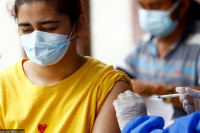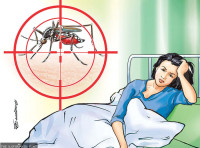Health
Over 5,000 infected with scrub typhus since January
Early treatment crucial to prevent deaths, say doctors. Actual death toll unknown due to lack of a tracking system.
Post Report
As many as 5,017 people have tested positive for scrub typhus in Nepal since January, data provided by the Epidemiology and Disease Control Division, show.
Some people infected with the life-threatening disease have succumbed to the infection, but the actual number is not known, as most health facilities across the country lack a proper system to determine the cause of death.
“People may have died from complications caused by scrub typhus, but doctors often report that patients died of multi-organ failure,” said Dr Gokarna Dahal, chief of the Vector Control Section at the division. “Due to a lack of a proper system to confirm causes of deaths, we are not in a position to say how many deaths were caused by scrub typhus.”
Scrub typhus, or bush typhus, is a potentially fatal infectious disease caused by the parasite Orientia tsutsugamushi, a mite-borne bacterium. It spreads to humans when bitten by infected chiggers (larval mites) found on mice.
In the fiscal year 2024-25, at least 16,597 people across the country were infected with scrub typhus. Of the total cases of infection, Lumbini province recorded 4,322 cases, the highest number in the country, followed by Sudurpaschim province (3,746 cases), Karnali (2,539), Koshi (2,119), Bagmati (1,838), Gandaki (1,725) and Madhesh province (308).
The number could be higher still, as all cases of infection do not enter government records.
What alarms health officials is that people living in urban settings are also getting infected with this disease. Until a few years ago, it was believed that only those residing in rural areas or those working in grasslands or fields were at high risk.
This life-threatening disease has emerged as a major public health problem of late, as thousands of people get infected and some also fall into a coma every year.
“Scrub typhus has emerged as a major public health problem in Nepal,” said Dahal, “People residing in both rural and urban settings are now getting infected.”
Nepal saw a surge in scrub typhus cases after the calamitous 2015 earthquakes that killed nearly 9,000 persons across the country.
Three months after the quakes, the BP Koirala Institute of Health Sciences, Dharan, alerted the Epidemiology and Disease Control Division about six children with unusual fevers and severe respiratory problems.
Serum samples were collected for subsequent tests in Kathmandu and Bangkok, which confirmed a scrub typhus outbreak. By then, four children had already died in the course of treatment. By the end of the year, 101 cases were confirmed in 16 districts, and four more people succumbed to the disease.
The outbreak escalated in 2016, when 831 cases were reported in 47 districts, and 14 people died by the end of that year.
According to the Ministry of Health and Population data, 1,026 people were infected with the disease in 2020. The number increased to 1,999 in 2021, and to more than 2,900 in 2022. In 2023, over 5,000 people were infected.
Doctors say the risk of severity and fatality can be minimised if patients are diagnosed and treated early.
Common antibiotics, such as doxycycline and azithromycin, which are on the government’s essential drugs list and distributed free to health facilities across the country, can cure the disease.
However, what is concerning is that many health workers, including doctors, lack sufficient knowledge about diagnosing scrub typhus. Many health facilities also lack reagents to carry out tests for the disease.
Doctors can diagnose the disease based on the symptoms, but the risk of misdiagnosis is high, as scrub typhus symptoms are similar to those of other illnesses.
Waiting for lab results before starting treatment can be dangerous as it can take about a week to get lab results and, by that time, the patient can fall into coma and suffer multi-organ failure.
The symptoms include high fever, headache, abdominal pain, backache, joint and muscle pain, red rash, nausea and vomiting. Patients with severe illness may develop bleeding, which could lead to organ failure. The infection can lead to respiratory distress, inflammation of brain, lungs, kidney failure and then multi-organ failure. If not treated immediately, the infection can be fatal.
Dengue cases hit 3,247 since January
Meanwhile, officials at the division said that at least three people have succumbed to dengue virus infection, and 3,247 others have been infected with dengue virus since January.
Dengue is a viral disease transmitted by female Aedes aegypti and Aedes albopictus mosquitoes. According to the World Health Organisation, the same vector also transmits chikungunya, yellow fever, and the Zika virus.
In 2024, 15 people died, and 41,865 others were infected as the virus spread to 76 districts. In 2023, 88 persons succumbed and more than 54,000 were infected by the virus, which had spread to all 77 districts.
At the time, hospitals in Kathmandu Valley were overwhelmed with dengue patients, and pharmacies had run out of paracetamol, the most widely used medicine to treat fever.
Since dengue became endemic in Nepal years ago, meaning people get infected throughout the year, health officials no longer classify it as an outbreak of a deadly virus.




 15.12°C Kathmandu
15.12°C Kathmandu













